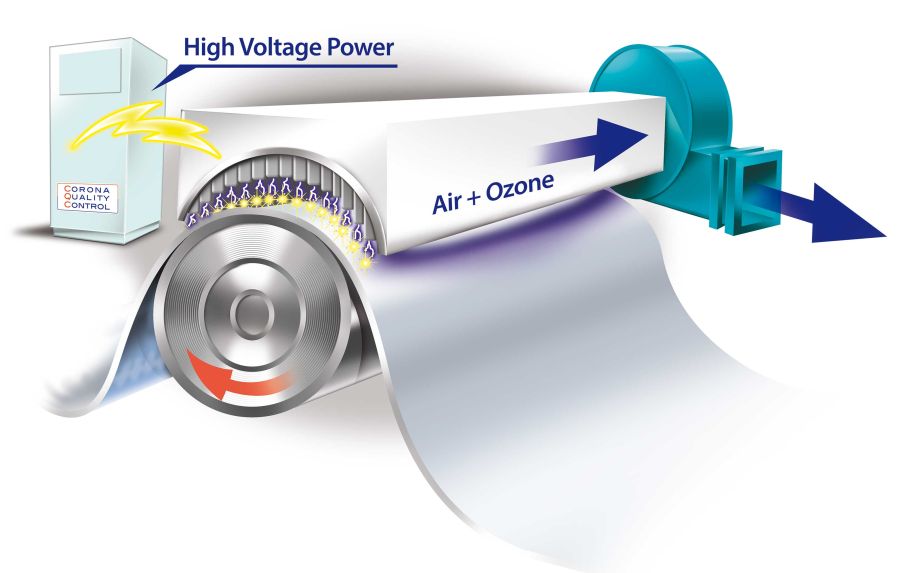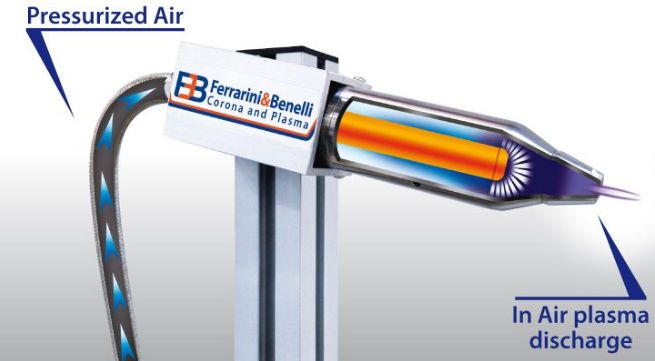1 Corona treatment
The Corona treatment is obtained by creating an electric discharge – with high voltage and high frequency – in a limited air gap (1 or 2 mm), both linear and uniform, between an electrode charged to high voltage (via a power generator connected to a voltage booster transformer) and a counter-electrode coated with insulating material (usually a roller) connected to earth.
The electric discharge causes an ionisation by collision: some ions in the air are accelerated by the electric field applied and collide with some neutral molecules, causing them to ionise. In turn, the new charged particles formed in that way ionise other molecules by collision in an avalanche effect that causes the dielectric breakage of the air.

For example, when electrons come into contact with polyethylene, they have enough energy to break the hydrogen-carbon or carbon-carbon bond. The radicals thereby formed react with the corona discharge, mainly in oxidation, leading to polar functional groups, which therefore provide the basis for the adhesion of printing inks, lacquers, adhesives, etc.
The corona discharge is best used on flexible materials (plastic film, metallised film, aluminium foil, paper) with a few exceptions for semi-rigid materials (plastic sheets like PE, PP, PVC or sheets no thicker than 10-15 mm).
The corona discharge is produced by electrodes that can be made to measure according to the width of the material to be treated. This is a clear advantage of the corona discharge compared to the Plasma treatment, because it can be used on film with various sizes:
- applications for labels or narrow-web treatment (width 200-400 mm)
- flexible packaging (typical width 1,300 - 1,500 mm)
- film extrusion (1,000 mm - 3,500 mm)
- wide-web treatment up to 8,000 mm.
Neither the width of the material nor the working speed pose a limit for the corona treatment. By identifying the right power for the generator, one can indeed adapt to the desired working speed (from 5 to 500 m/min).
2 Plasma treatment
Plasma is the so-called fourth state of matter. Almost any substance solidifies at low temperatures. By applying a certain amount of energy by heating it, it changes to the liquid state and by adding more energy it passes to the gaseous state. By adding energy to the gas, the molecules break down into atoms and electrons and reach the plasma state.
Plasma treatment does not produce ozone!.

Atmospheric plasma
Atmospheric plasma is achieved by creating an electric field in the air and directing the discharge onto the substrate to be treated. It is usually obtained in the air, but it is also possible to use gas. Atmospheric plasma treatment is point-based and therefore better suited for small surfaces.
The plasma discharge is indeed obtained from a nozzle placed on the production line in a fixed position. The materials to be treated pass in front of the nozzle and are treated. As the plasma discharge is point-based, it reaches high levels of energy and very high surface tension levels, especially on plastic materials.
Applications worth mentioning include the treatment of electric cables, hydraulic pipes (to improve bonding for the inks used for printing or coding), collapsible boxes before the gluing stage, metal parts for deep cleaning, plus a treatment to make seals easier to glue.
Larger surfaces can be treated as well:
- scan of the surface to be treated by mounting the plasma torch on a mechanical arm driven by an automation system
- use of several plasma torches to increase the surface being treated.
| Corona | Atmospheric Plasma |
|---|
Surface activation | Electric discharge in a limited and linear space, between an electrode and isolated and earthed counter-electrode (collision ionisation) | In air discharge: the plasma removes the contaminated particles and increases the surface energy |
Materials to be treated | Plastic wide webs, foils (PE, PP, PVC) or sheets with thickness up to 10-15 mm, metallised film, aluminium foil or paper | Small plastic objects, small plane surface, cables, tubes, sections, metallic parts |
Production speed | Up to 600 m/min | Up to 50 m/min |
Main goals | To enhance the bonding and to prevent detatching of coatings, paints or adhesives from the support | To ensure maximum adhesion, deep cleaning and anchoring of glues, adhesives and inks, to improve water repellence… |
Ozone production | YES | NO |
Sectors | Film extrusion, sheet extrusion, flexible packaging converting, packaging | Electrical cables, hydraulical pipes, automotive, medical, packaging, household appliances, electronic. |
Installation | Continuous processing and reel-to-reel films. | Continuous processing, installation on robotic arms for piece by piece productio |
Vacuum Plasma
Vacuum plasma is obtained in a vacuum chamber filled with a set volume of gas on which an electric field is applied. This technology is mainly used to treat three-dimensional objects of various sizes introduced in the plasma chamber. This process is best suited to small parts that can be introduced inside the plasma chamber in large amounts. However, the treatment can still be carried out on large parts by adapting the plasma chamber.
The process is not suitable for continuous processing or to treat reel-to-reel materials/film. By introducing certain gases and substances in the plasma chamber, it is also possible to obtain special coatings on plastic supports: the coating is deposited by a chemical reaction triggered by the gas in the plasma field, which ensures optimal bonding.
Corona + Plasma
The new frontier is to be able to apply a discharge + gas on flexible materials in reel-to-reel applications. By adding the potential of Corona systems to that of Plasma systems, along with the development of chemical reagents, specific properties of materials can be further improved (wettability, hydrophilic and hydrophobic properties, nano-coating, resistance, anti-fog and anti-bacterial properties, etc.).
These systems, called atmospheric plasma treatments, are also suitable for continuous processing. They are still being developed and are opening the way to new applications.
Ferrarini & Benelli has more than 55 years of experience in corona treatments and it has been manufacturing atmospheric plasma stations with torches for about 15 years.